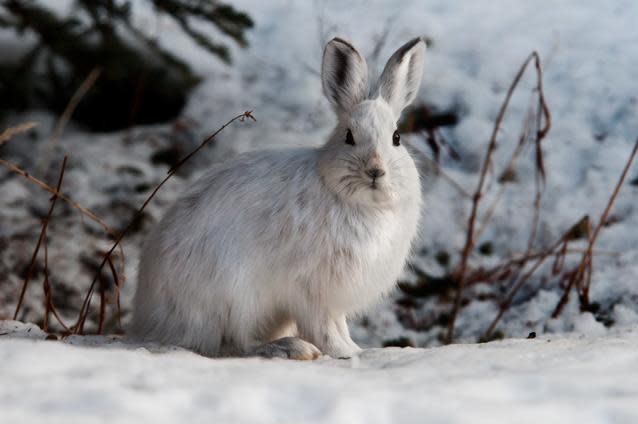Hares no longer turning white during winter due to impact of climate change

Animals may be losing their ability to display adaptive camouflage because of changing environmental conditions.
Snowshoe hares, ermines, caribou and arctic foxes all change colour from darker to lighter colours during winter, in order to blend into snow-covered landscapes.
With warmer winters come less snow, and it is thought the hares have adjusted their survival techniques in areas that have warmed faster than others.
There is greater change in the winter coats of populations of hares in more southerly areas, according to research published in the Canadian Journal of Zoology,
A research team looked at populations of hares living in Pennsylvania in the eastern US, and Yukon, much further north in west Canada.
In addition to finding greater numbers of the animals with thinner winter coats in the more southerly population, they found a small number of individuals which did not develop a full winter pelt.
We trapped three hares in January that were almost completely brown, and it's the first time that has been recorded in eastern North America," lead researcher Laura Gigliotti told ScienceDaily.com. “There are hare populations in the Cascades in Washington that don't moult completely, but that had not been documented elsewhere.”
The team believe this could be an adaptation to warmer climate, giving the animals the advantages of a more appropriate level of insulation, and greater likelihood of camouflage in less snowy areas.
Non-hibernating mammals are good indicators of the impact climate change has on animals – they do not hibernate, so winter temperature fluctuations and snow cover are thought to affect them the most.
The team also investigated how hares in Pennsylvania altered their movement rates and resting spot selection as a response to variable winter temperatures.
They discovered hares from Pennsylvania had shorter, less dense, and less white winter coats than their northern counterparts, suggesting lower coat insulation.
They found they also had lower pelage temperatures (fur insulation), indicating they produced less heat than those in the northern population.
In addition, hares in Pennsylvania did not choose resting spots that offered thermal advantages, but instead selected locations offering visual obstruction from predators.
“Our results indicate that snowshoe hares may be able to adapt to future climate conditions via changes in pelage characteristics, metabolism and behaviour,” said Ms Gigliotti. “Unfortunately, we don't know if they can adapt as quickly as climate change is occurring.”
Recent studies by the same researchers studied how the hares make greater use of denser vegetation for cover during bright moonlit nights. The team believe some populations of hares respond to their surroundings and adjust their behaviour accordingly, while other populations from the same breed do not.

 Yahoo News
Yahoo News 